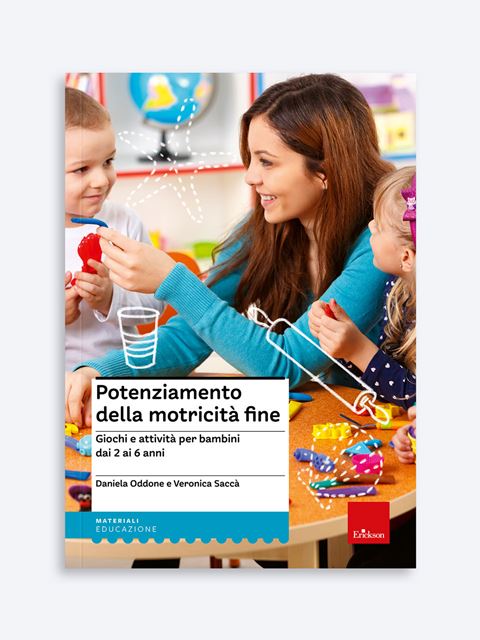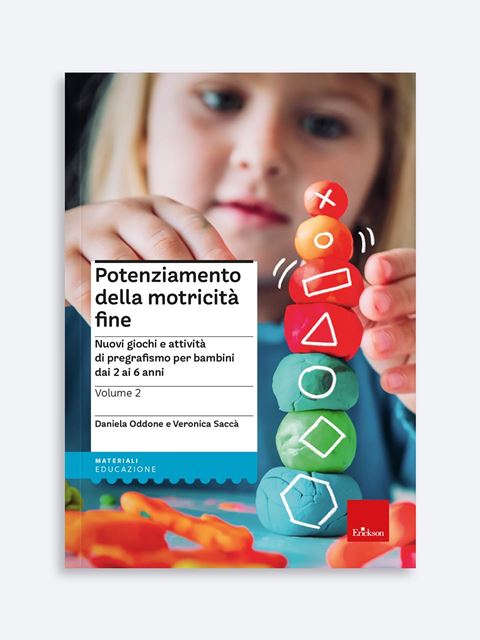 EN
EN
 PT
PT
New pre-writing games and activities for children ages 2 to 6 years
Product: Book
Trim size in cm: 21x29,7cm
Pages: 144
ISBN: 9788859029090
Publication date: 01/09/2022
Suitable for: Nursery 1st Level (ages 3-4), Nursery 2nd Level (ages 4-5)
REQUEST A SAMPLE OR MORE INFORMATION
The volume offers examples of targeted activities, to be carried out together with children aged 2 to 6, to enhance fine motor skills and to promote the correct development of some of the motor prerequisites necessary for learning to write. Divided into 3 sections, one for each age group of psychomotor development, the book proposes activities aimed at improving:
The volume is completed by an Appendix, in which the traced paths are examined, with theoretical elements and a description of the activity, motor exercises to enhance motor skills and tonic regulation of the upper extremities, and photocopiable worksheets to be used with the games; the same worksheets, in colour, are available and downloadable from Online Resources, using the access code on the book’s front page.
Attached are coloured materials to be used in many activities, including cards and a board for an original game the goose.
Suggested for
The book is a valuable tool for parents, educators, preschool teachers, operators and therapists who work with children with learning difficulties and can be used both at home and in education and rehabilitation.
Introduction
Ch. 1 Fine motor skills
Section 1 – 2-3 years
Section 2 – 3-4 years
Section 3 – 5-6 years
Worksheets
Appendices
Bibliography

Games and activities for children from ages 2 to 6

As Piaget claims, movement plays a fundamental role in an individual’s development. The development of motricity takes place immediately after birth and continues gradually in well-defined stages, leading the child to perform increasingly complex and precise movements. In fact, through movement, children learn about the environment around them, developing spatial and temporal coordination and their cognitive abilities.
The two volumes of Improving Fine Motor Skills offer activities and games, to be carried out with DIY materials, aimed at improving precision and hand-eye coordination, enhancing fine motor skills and promoting the correct development of some of the motor prerequisites necessary for learning to write, as well as fostering creativity, attention skills, and imagination.
Objectives
The development of fine motor skill s a process that is not always represented by linear progress. Sometimes it is faster, sometimes slower, depending on the individual. This book can be a valuable tool for nursery school teachers, parents, educators and therapists to offer and stimulate the carrying out of daily actions, accompanying the child in his/her personal growth progress through games.
The volumes in the series
The volumes propose different activities grouped into 3 sections, one for each age group of psychomotor development (2-3 years, 3-4 years, 5-6 years). The materials used are readily available, and natural and daily actions are suggested to the child.
Each book includes:


Improving Fine Motor Skills – Volume 1
The book features games and activities to improve accuracy, manual skills and hand-eye coordination.

Daily actions, such as threading, unscrewing, screwing, shaping, coloring, cutting and activities are divided into three sections:
SECTION 1 (from 2 to 3 years): activities to encourage coordination, increase attention, visual tracking and dexterity (dimensional concepts, associating images and colours, using symbols).
SECTION 2 (from 3 to 4 years): activities to improve the specific coordination skill of control and regulation of arm and hand movements.
SECTION 3 (from 5 to 6 years): activities aimed at the development of the fine motor skill prerequisites necessary for learning to write (individual finger movements, correct positioning, managing the space of a piece of paper).
Leaf through some pages of the book which have been translated into English to facilitate your evaluation of the product.
Improving Fine Motor Skills – Volume 2

The book offers games and activities to enhance fine motor skills and promote the correct development of some of the motor prerequisites necessary for learning to write. The activities are divided into three sections:
SECTION 1 (from 2 to 3 years):hand-eye coordination, attention, dexterity, knowledge of dimensional concepts, colors, shifts, etc;
SECTION 2 (from 3 to 4 years): the regulation of upper limb and hand movements, fine motor skills and finger movements;
SECTION 3 (from 5 to 6 years): fine motor skill development, including correct grasp and grip, concentration, as well as posture.
Leaf through some pages of the book which have been translated into English to facilitate your evaluation of the product.
The Authors
Daniela Oddone She has a degree in Neuro Therapy and Developmental Psychomotricity at the University of Pisa, and currently works in Genoa at a private affiliated center specializing in the treatment of developmental disorders.
Veronica Saccà She graduated from Neuro Therapy and Developmental Psychomotricity at the University of Messina, and works as a Third Party Operator, Educator of the graphic gesture AED (European Disgraphies Association) and an AIMI Infant Massage teacher. She deals with evaluation and neuropsychomotor treatment for children with developmental disorders.